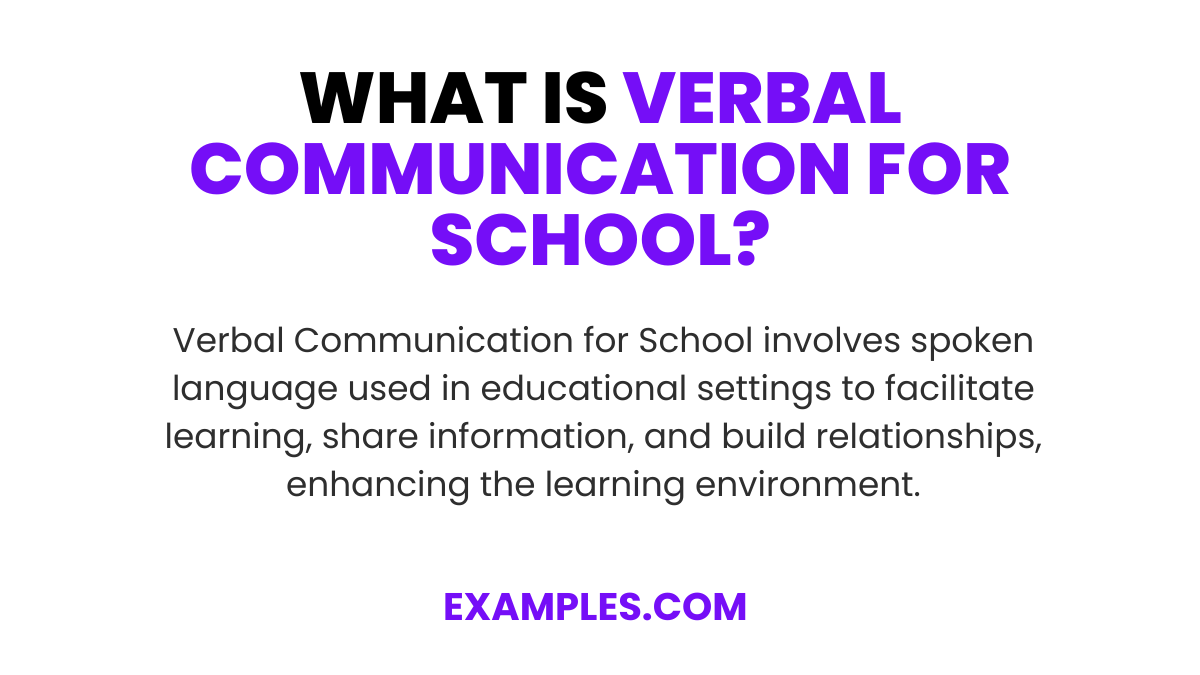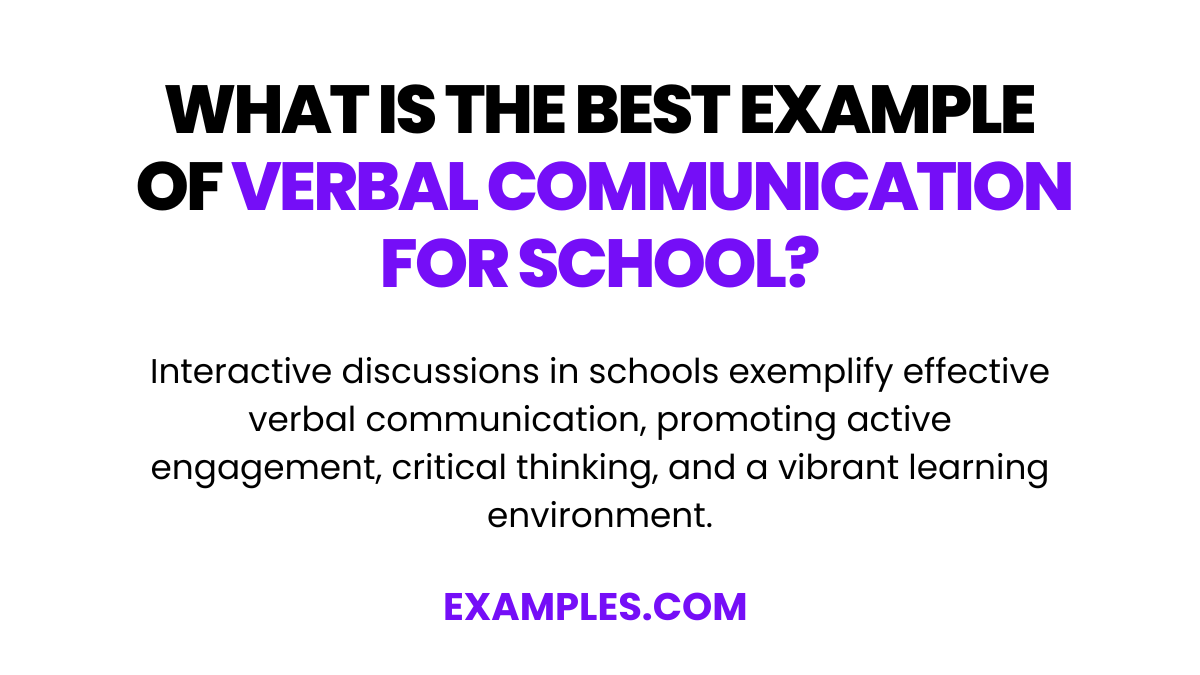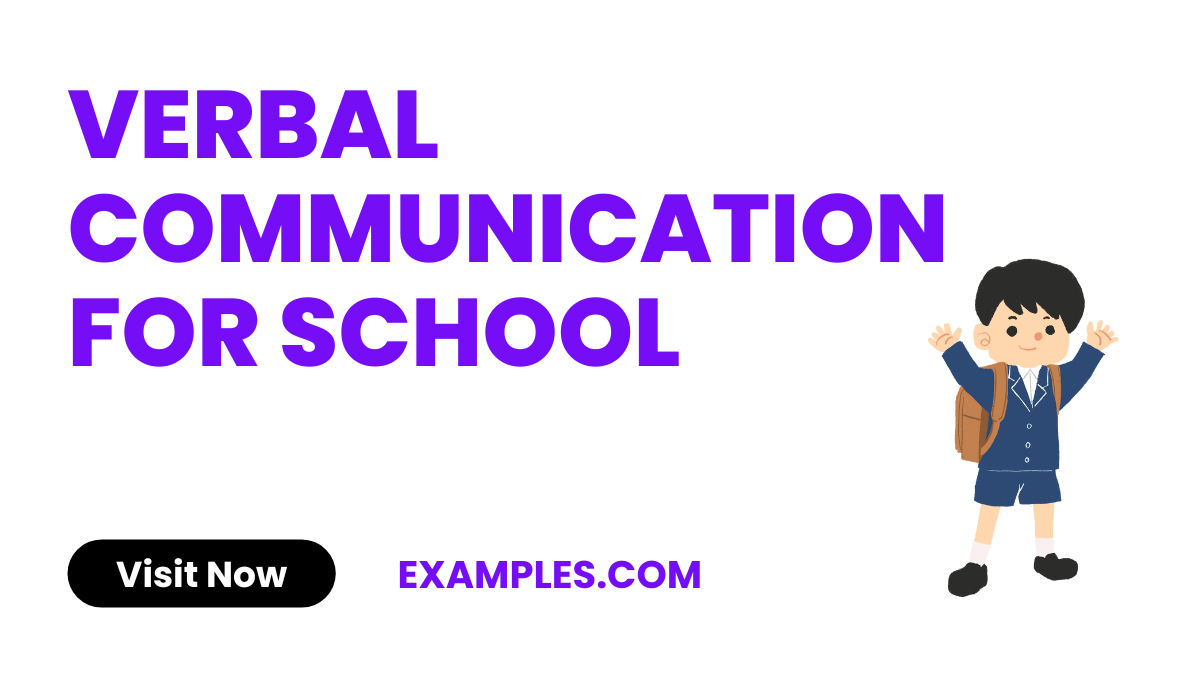19+ Verbal Communication for School Examples
Navigate the intricate world of educational dialogue with our all-encompassing guide on Verbal Communication for School. This resource is packed with practical Communication Examples that illuminate the ways verbal communication shapes the educational experience. From enhancing teacher-student interactions to fostering a collaborative classroom environment, discover the strategies and insights essential for cultivating a thriving educational atmosphere.
Download Verbal Communication for School FAQs PDF
What is Verbal Communication for School? – Meaning

Verbal Communication for School refers to the spoken language used within educational environments to facilitate learning, share information, and build relationships. It encompasses a wide range of interactions, from classroom instructions and student discussions to teacher feedback and peer collaboration. Effective verbal communication is foundational in creating an engaging and supportive learning environment, ensuring that information is conveyed clearly and learning is a dynamic, interactive process.
What is the Best Example of Verbal Communication for School?

A prime example of verbal communication in schools is the interactive discussion. In this setting, a teacher poses a thought-provoking question, prompting students to express their ideas, debate concepts, and listen to peers. This dialogue not only enhances understanding of the subject matter but also develops critical thinking and public speaking skills. Interactive discussions exemplify how Verbal Communication for Teacher can be used to engage students actively, encourage diverse perspectives, and create a vibrant learning community.
20 Verbal Communication for School Examples

Delve into the realm of Verbal Communication for School with a diverse array of examples designed to enhance educational experiences. This compilation not only showcases Verbal Communication Examples but also highlights the significance of understanding What Percent of Communication is Verbal? Explore effective Verbal Communication Techniques that address the Advantages and Disadvantages of Verbal Communication. Grasp the essential Functions of Verbal Communication, learn about different Types of Verbal Communication, and refine essential Verbal Communication Skills. Discover Ways to Improve Verbal Communication Skills and comprehend the nuances between Verbal vs Written Communication and Verbal vs Oral Communication for a more comprehensive and effective educational dialogue.
- Morning Announcements: Sharing daily news and schedules.
Cause: Informing the school community. Fix: Ensure clarity and brevity. - Classroom Instruction: Delivering lesson content.
Cause: Educational delivery. Fix: Use clear, age-appropriate language. - Peer Tutoring: Students helping students understand material.
Cause: Collaborative learning. Fix: Encourage open-ended questions. - Parent-Teacher Conferences: Discussing student progress.
Cause: Parental involvement. Fix: Be clear, concise, and empathetic. - Student Presentations: Sharing research or projects.
Cause: Skill development. Fix: Provide guidelines and practice opportunities. - Teacher Feedback: Offering constructive criticism.
Cause: Learning improvement. Fix: Balance praise with actionable suggestions. - Student Debates: Engaging in argumentative discussions.
Cause: Critical thinking. Fix: Set clear rules and objectives. - Drama and Role Play: Practicing expressive language.
Cause: Creative expression. Fix: Guide with scenarios and debrief. - Reading Aloud: Enhancing literacy skills.
Cause: Language development. Fix: Choose engaging and appropriate texts. - Bilingual Education: Teaching in multiple languages.
Cause: Linguistic diversity. Fix: Use language transition techniques. - School Assemblies: Addressing the entire student body.
Cause: Community messaging. Fix: Use engaging, clear language. - Library Story Time: Encouraging a love for reading.
Cause: Literacy enjoyment. Fix: Interactive and animated storytelling. - Group Projects: Facilitating cooperative communication.
Cause: Teamwork. Fix: Assign roles and provide communication strategies. - Book Club Discussions: Analyzing literature together.
Cause: Deep learning. Fix: Guide with thematic questions. - Science Fair Presentations: Explaining projects and findings.
Cause: Knowledge application. Fix: Teach presentation skills. - Math Problem-Solving: Talking through solutions.
Cause: Comprehension. Fix: Encourage step-by-step verbalization. - Sports Coaching: Giving instructions and feedback.
Cause: Physical education. Fix: Use clear, motivational language. - Art Critiques: Discussing artistic works.
Cause: Aesthetic appreciation. Fix: Foster descriptive and respectful language. - Health and Safety Drills: Practicing emergency communication.
Cause: Preparedness. Fix: Regular drills and clear instructions. - Counseling Sessions: Providing support and guidance.
Cause: Emotional well-being. Fix: Encourage open, trustful dialogue.
Verbal Communication for School Students
Enhance the educational journey with effective Verbal Communication for School Students. This guide focuses on developing skills that foster understanding, expression, and collaboration among students. Explore the methods that enable students to articulate thoughts clearly, participate actively in learning, and build meaningful relationships, all while navigating the daily dynamics of school life. Understand the role of effective verbal interaction as a cornerstone of student success and a vibrant school community.
- Asking Questions in Class: Encouraging curiosity and clarification. “Can you explain how this math formula works?”
- Participating in Group Work: Collaborating and sharing ideas. “I think if we divide the tasks, we can complete the project more efficiently.”
- Expressing Needs to Teachers: Communicating personal learning requirements. “I learn better with visual aids; can we use more in class?”
- Peer Mentoring: Older students guiding younger ones. “Let me show you a trick to remember these historical dates.”
- Conflict Resolution among Peers: Addressing disputes constructively. “I understand you’re upset; let’s find a way to solve this together.”
Verbal Communication for School in Nursing
Dive into the specialized field of Verbal Communication in Healthcare tailored for nursing students within school settings. This guide provides insights into effective Verbal Communication for Students that are vital in nursing education, focusing on patient interaction, teamwork, and professional development. Learn about the tailored techniques that future healthcare professionals use to ensure clear, compassionate, and accurate communication, essential in the fast-paced and often high-stakes environment of healthcare.
- Explaining Medical Procedures: Simplifying complex healthcare terms. “This medication will help alleviate your pain by reducing inflammation.”
- Patient Education: Informing patients about their care. “It’s important to take the entire course of antibiotics to ensure recovery.”
- Team Briefings: Collaborating with healthcare teams. “In today’s shift, we need to focus on patient X’s post-operative care.”
- Empathy in Patient Interactions: Showing understanding and concern. “I know this can be a bit overwhelming, we are here to support you every step of the way.”
- Reporting to Supervisors: Conveying patient status and needs. “The patient in room 5 is showing signs of improvement but requires continued monitoring for any changes.”
What Strategies Promote Collaborative Verbal Communication for School Projects and Group Work?
Promoting collaborative verbal communication in school projects and group work is essential for student success and team synergy. Effective strategies enhance How to Improve Verbal Communication Skills among students, facilitating a more productive and enjoyable learning experience.
- Clear Role Assignments: Start by defining each member’s role and responsibilities to avoid confusion and overlap.
- Active Listening Techniques: Encourage students to practice active listening, ensuring that each member’s ideas are heard and valued.
- Regular Check-Ins: Schedule regular meetings or check-ins to discuss progress, address concerns, and adapt plans as needed.
- Conflict Resolution Protocols: Establish clear guidelines for resolving disagreements, emphasizing respect and constructive dialogue.
- Feedback Sessions: Implement structured feedback sessions allowing students to share insights and improvements in a supportive environment.
What is the Importance of Verbal Communication for School?
The importance of verbal communication in schools cannot be overstated. It is vital for effective teaching, learning, and building a cohesive school environment, directly impacting the Importance of Verbal Communication in educational success.
- Facilitates Learning: Clear verbal communication helps students understand and absorb material more effectively.
- Enhances Teacher-Student Relationships: Open and Effective Communication fosters trust and respect between teachers and students.
- Promotes Social Skills: Students develop critical social skills through daily verbal interactions with peers and teachers.
- Improves Academic Performance: Strong Communication Skills are associated with better academic results and higher engagement.
- Supports Emotional Development: Verbal expression is key to emotional growth and understanding one’s own and others’ feelings.
How Does Verbal Communication for School Differ Between Elementary, Middle, and High School Levels?
Verbal communication evolves significantly as students progress from elementary to high school, reflecting cognitive and social development. Understanding these differences is key to tailoring Why you need Verbal Communication Skills at each educational stage.
- Elementary Level: Focuses on basic language skills, storytelling, and simple explanations. Communication is more direct and often requires concrete examples.
- Middle School Level: Introduces more complex language and abstract thinking. There’s an increased emphasis on discussion, debate, and expressing individual thoughts.
- High School Level: Encourages sophisticated language use, critical analysis, and independent thought. Communication becomes more nuanced, reflecting deeper understanding and personal identity.
- Across All Levels: Despite these differences, the Rules of Verbal Communication remain constant, emphasizing clarity, respect, and adaptability.
- Adjustments in Teaching: Teachers adapt their Verbal Communication Techniques to match the developmental stage, ensuring that instructions and discussions are age-appropriate and engaging.
How does Effective Verbal Communication for School Impact Students’ Academic Success?
Effective verbal communication enhances understanding, boosts confidence, promotes engagement, and improves collaborative learning, leading to greater academic success and comprehension.
What Role Does Verbal Communication Play in Creating a Positive School Environment?
Verbal communication fosters respect, understanding, and cooperation among students and staff, creating a positive, inclusive, and supportive school environment.
How can Teachers Enhance Their Verbal Communication for School Settings?
Teachers can enhance communication by actively listening, providing clear instructions, giving constructive feedback, adapting to diverse needs, and continuously developing their interpersonal skills.
In conclusion, effective verbal communication in schools is a cornerstone of successful education. This article explored its importance, effects on student engagement and learning, signs of improvement, and strategies for enhancement. By recognizing its value, implementing best practices, and fostering an environment that encourages open dialogue, schools can empower students, educators, and administrators to thrive academically and socially, paving the way for a brighter future.



